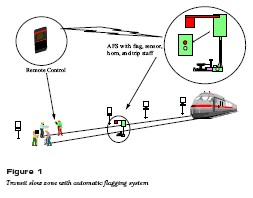The safety of track maintenance workers is a vital concern, especially where high-speed trains are operating. These maintenance workers must often rely on a socalled flagman or watchman who is assigned the responsibility of watching for approaching trains, and alerting workers in time to clear all personnel and equipment from the right-of-way before the arrival of trains. This technique is labor intensive and not always effective. Occasionally, those assigned the job of spotting trains do not see them in time to provide adequate warnings. This can, and does, result in fatal accidents and untold near collisions.
As a result of this concern, there is a need to develop a low-cost, reliable, automatic system to provide effective warnings to track workers of approaching trains.
The concept on which this project is based is the detection of train-induced rail vibrations to activate a warning system for track maintenance workers. The application of this technology for train detection was examined in a previous IDEA project (HSR-4). This follow-on project was to develop a warning system that combines the moving train sensor with a robotic signaling and train stop device. Initial application was to be designed for rail transit applications, such as on the Chicago Transit Authority (CTA). Currently, a “slow zone” is established at a track maintenance work site, and a “trip staff” that will automatically stop the train is installed on the tracks. When a train approaches the “slow zone” the flagman sounds a horn to alert the track workers that a train has entered the zone, and signals the train operator to halt with a flag or light. After receiving a track-clear signal from the foreman, the flagman removes the trip staff and signals the train to proceed.
This project was to investigate the feasibility of a robotic signaling device to replace the flagman (Figure 1). The robot would be designed to place and remove the trip staff, and would be under the control of the track maintenance foreman by means of a hand-held device with a radio frequency link to the robot. The primary objective was to determine whether rail vibration technology could be used to detect the presence and speed of trains approaching track maintenance work zones.

The final report for this IDEA project can be found at: